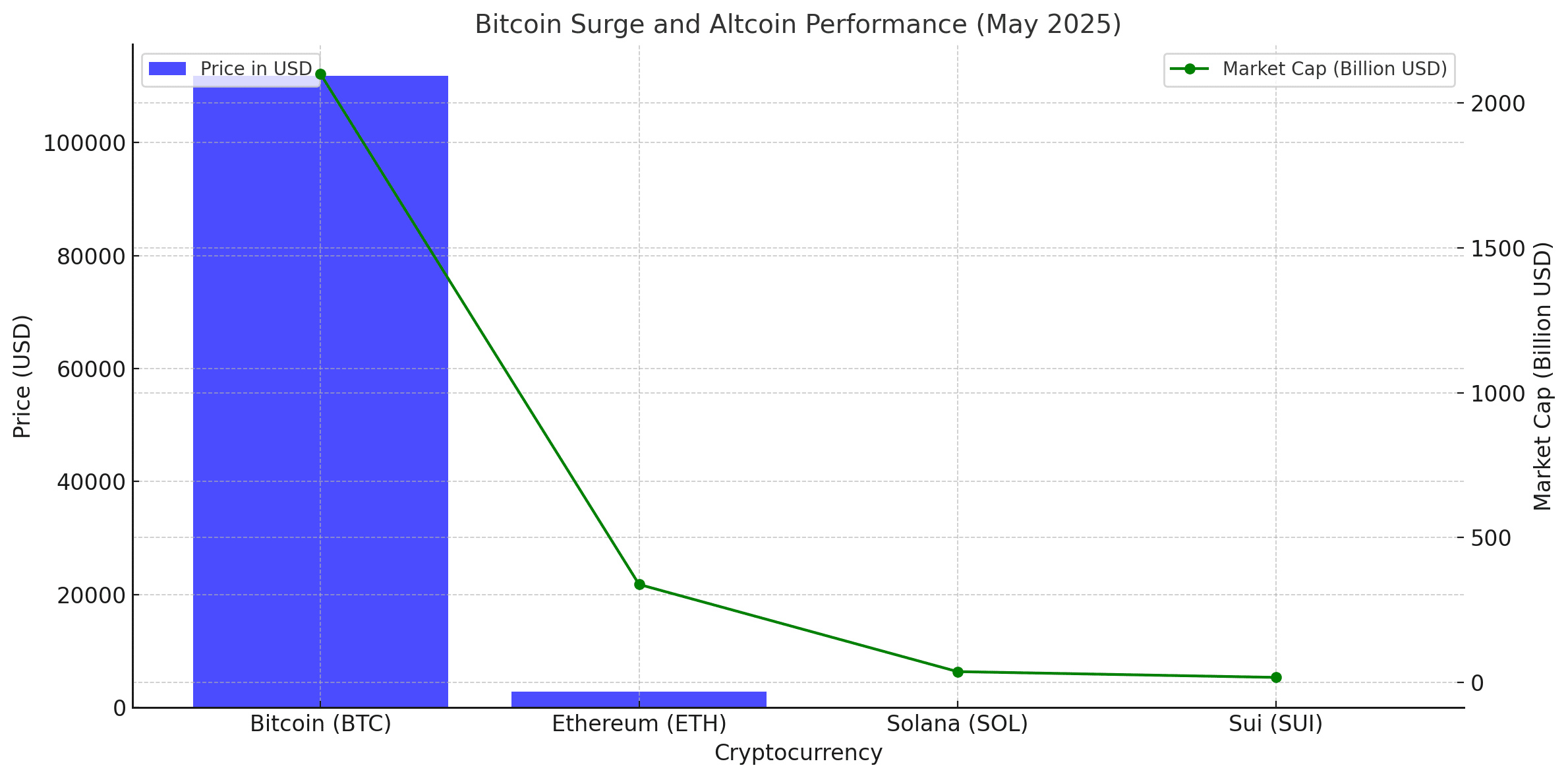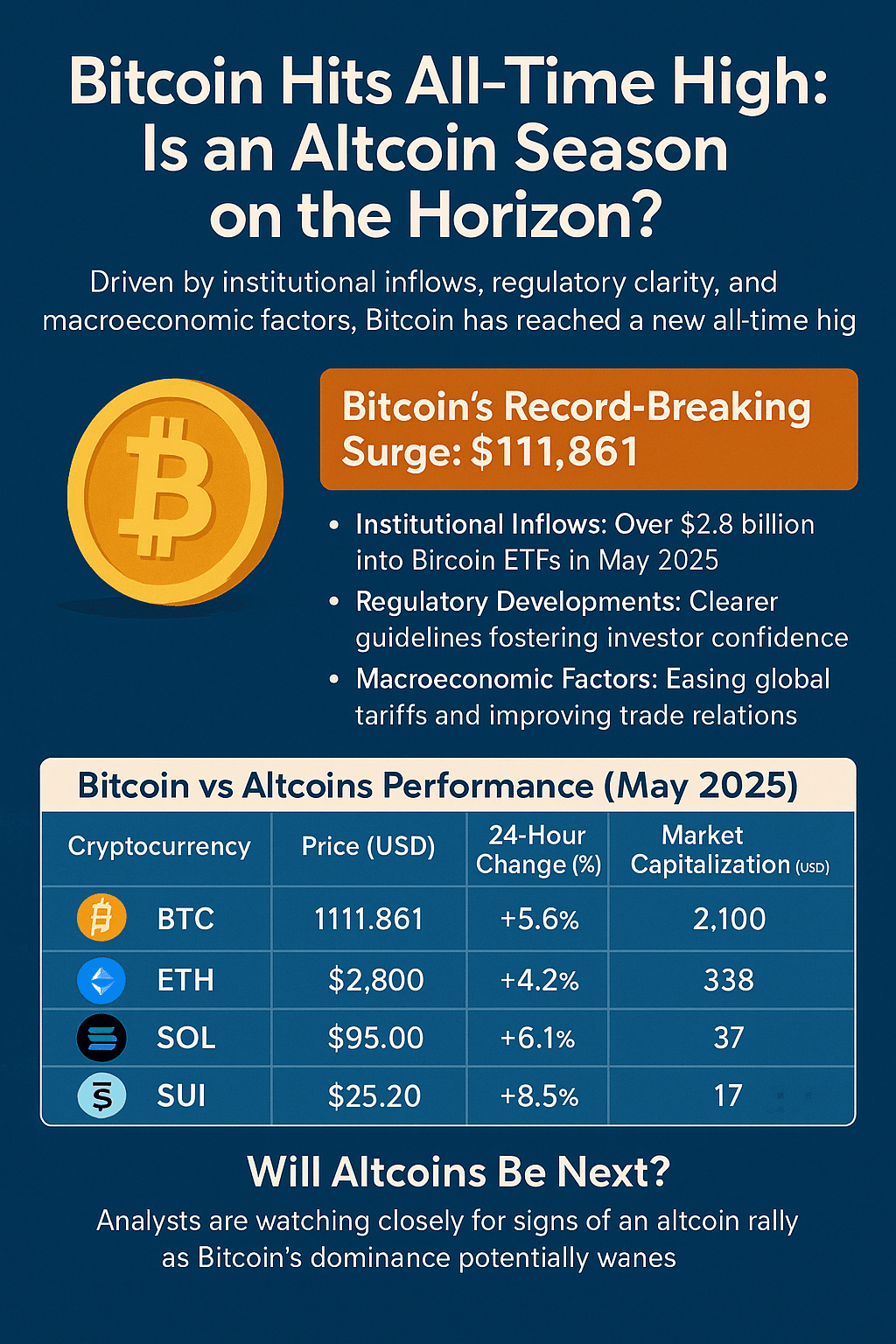The cryptocurrency market has been witnessing a tremendous surge in Bitcoin’s value, hitting an all-time high of $111,861. A combination of strong institutional inflows, favorable regulatory developments, and macroeconomic factors drives this sharp upward movement.
- Bitcoin’s Record-Breaking Surge: What’s Driving It?
- Institutional Inflows Fuel Bitcoin’s Rise
- Regulatory Clarity Drives Investor Confidence
- Macroeconomic Factors Supporting the Bull Run
- The Potential for an Altcoins Season
- What Drives the Altcoin Season?
- Conclusion
- FAQs
- What is an Altcoin Season?
- Which Altcoins are Expected to Perform Well in 2025?
- Why is Bitcoin’s Price Rising?
- Glossary of Key Terms
With Bitcoin leading the charge, the question on every investor’s mind is: Are altcoins next in line for a significant rally?
Bitcoin’s Record-Breaking Surge: What’s Driving It?
Bitcoin’s rally to over $111,000 is not a random occurrence. Several factors have contributed to the asset’s meteoric rise. These include institutional interest, ETF inflows, regulatory clarity, and favorable macroeconomic conditions.
Institutional Inflows Fuel Bitcoin’s Rise
One of the primary factors behind Bitcoin’s recent surge is the continued institutional investment in the cryptocurrency market. Bitcoin Exchange-Traded Funds (ETFs) have seen over $2.8 billion in inflows in May 2025 alone, bringing the total holdings in Bitcoin ETFs to over $122 billion. These massive inflows reflect institutional confidence in Bitcoin’s long-term prospects, signaling that large investors are positioning themselves to capitalize on the growing digital asset class.
Institutional investors, such as hedge funds and family offices, are increasingly viewing Bitcoin as a hedge against inflation and a store of value. The increasing adoption of Bitcoin as an asset class by institutional investors is one of the key drivers of its current price rally.

Regulatory Clarity Drives Investor Confidence
In addition to institutional investment, regulatory clarity in major markets like the U.S. has played a pivotal role in boosting investor confidence. In recent months, regulators have taken a more structured approach to cryptocurrency, providing clear guidelines for trading and investing. This has reassured both retail and institutional investors that the regulatory environment for Bitcoin is stabilizing, further encouraging market participation.
Macroeconomic Factors Supporting the Bull Run
Favorable macroeconomic conditions have also supported Bitcoin’s rise. Easing global tariffs and improving trade relations have created a more stable environment for digital assets. As traditional financial markets see a recovery, Bitcoin benefits from its status as a non-correlated asset, providing investors with a diversification tool amidst ongoing global uncertainties.
The Potential for an Altcoins Season
With Bitcoin reaching new heights, many analysts are speculating that an “altcoin season” could be on the horizon. Altcoins, which have often lagged behind Bitcoin during bull runs, are expected to see significant gains if Bitcoin maintains its momentum.
Bitcoin Dominance and Altcoin Performance
Bitcoin’s dominance in the cryptocurrency market has historically been around 60-70%, but analysts suggest that if this dominance continues to decrease, capital will flow into altcoins, triggering a market-wide rally.

Currently, altcoins like Ethereum (ETH), Solana (SOL), and Sui (SUI) are showing promising signs of growth, thanks to their scalability and strong developer communities. Ethereum’s push towards Ethereum 2.0, which aims to improve scalability and reduce energy consumption, is also boosting investor sentiment toward the coin.
Bitcoin vs Altcoins Performance (May 2025)
| Cryptocurrency | Price (USD) | 24-Hour Change (%) | Market Capitalization (Billion USD) |
|---|---|---|---|
| Bitcoin (BTC) | $111,861 | +5.6% | $2,100 |
| Ethereum (ETH) | $2,800 | +4.2% | $338 |
| Solana (SOL) | $95.00 | +6.1% | $37 |
| Sui (SUI) | $25.20 | +8.5% | $17 |
This table shows how Ethereum, Solana, and Sui are performing alongside Bitcoin. Solana and Sui have shown impressive growth due to their technical advancements and growing ecosystem of developers, making them prime candidates for significant gains in the event of an altcoin season.
What Drives the Altcoin Season?
Liquidity and Market Capitalization
The key to an altcoin season lies in liquidity. As Bitcoin continues to surge, liquidity moves across the crypto ecosystem, often spilling into smaller altcoins. This is particularly evident after Bitcoin halving events, where Bitcoin’s supply decreases, causing its price to rise. Investors then start to diversify into altcoins, leading to a market-wide rally.
Ethereum and Smart Contract Platforms
Ethereum remains the dominant smart contract platform, powering decentralized applications (dApps) and DeFi protocols. As Ethereum continues its transition to Ethereum 2.0, scalability improvements will likely lead to higher adoption and more investor interest. Ethereum’s strong developer activity and growing decentralized finance (DeFi) ecosystem put it at the forefront of the altcoin market.
Solana and Sui are also benefiting from their focus on scalability and lower transaction fees compared to Ethereum. As adoption of these platforms grows, they could play a significant role in the upcoming altcoin season.
Conclusion
Bitcoin’s $111,861 surge marks an exciting moment for the cryptocurrency market. The continued institutional interest, favorable regulatory developments, and broader macroeconomic factors are all contributing to a bull run that could have significant implications for altcoins. If Bitcoin’s dominance decreases and liquidity spreads across the market, an altcoin season could follow.
As the crypto landscape continues to evolve, Ethereum, Solana, and Sui are expected to lead the charge, with increased adoption and strong technical upgrades. Investors should stay vigilant, watch for opportunities, and diversify their holdings to capture potential growth in the coming months.
FAQs
What is an Altcoin Season?
An altcoin season refers to a period when alternative cryptocurrencies (altcoins) experience a significant increase in value, often following a Bitcoin rally.
Which Altcoins are Expected to Perform Well in 2025?
Altcoins like Ethereum (ETH), Solana (SOL), and Sui (SUI) are expected to perform well due to their scalability, active developer communities, and technological advancements.
Why is Bitcoin’s Price Rising?
Bitcoin’s rise is fueled by institutional inflows, positive regulatory developments, and favorable macroeconomic conditions, such as easing global tariffs and improving trade relations.
Glossary of Key Terms
Bitcoin (BTC): The first decentralized digital currency, often seen as a store of value and a hedge against inflation.
Altcoin: Any cryptocurrency that is not Bitcoin, such as Ethereum, Solana, or Sui.
Altcoin Season: A period when altcoins experience significant price increases after Bitcoin’s rise.
Bitcoin ETF: Exchange-Traded Funds that allow institutional investors to gain exposure to Bitcoin without directly owning it.
Institutional Inflows: The investment of large institutions like hedge funds or banks into Bitcoin or other cryptocurrencies.
Market Dominance: The percentage of the total cryptocurrency market capitalization that Bitcoin holds.
Ethereum (ETH): A leading smart contract platform, the second-largest cryptocurrency by market capitalization.
Solana (SOL): A high-performance blockchain known for its scalability and speed, often seen as an alternative to Ethereum.
Sui (SUI): A scalable blockchain platform designed for decentralized applications and digital assets.
Exchange-Traded Funds (ETFs): Investment funds that are traded on stock exchanges, offering exposure to Bitcoin or other assets.



















































































































